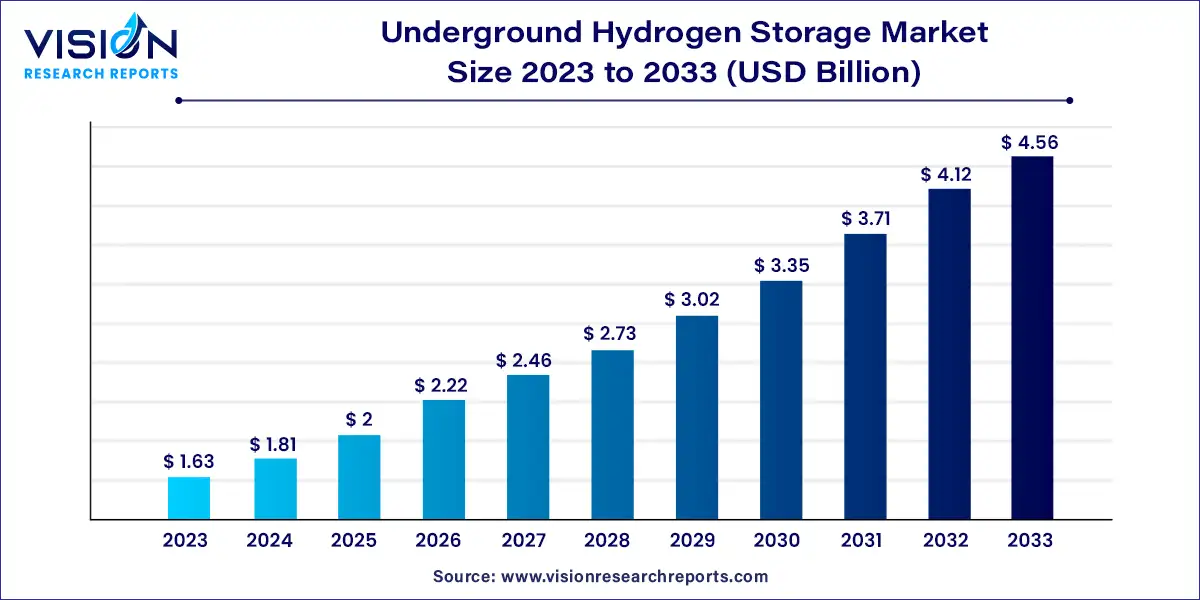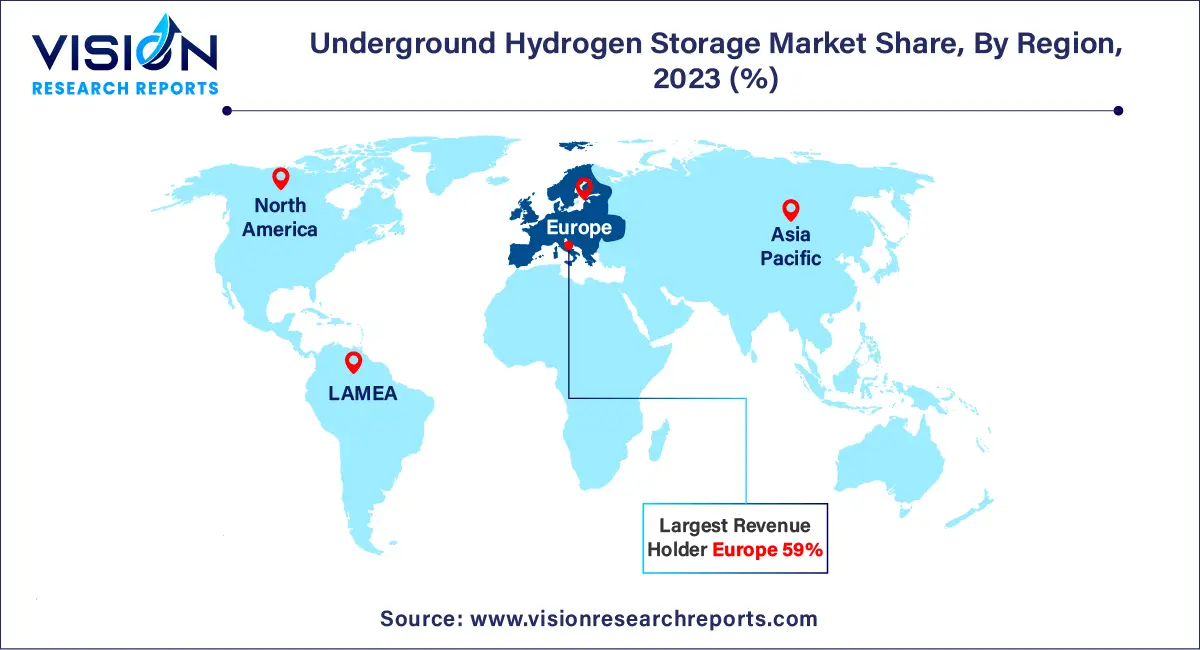The global underground hydrogen storage market size was estimated at around USD 1.63 billion in 2023 and it is projected to hit around USD 4.56 billion by 2033, growing at a CAGR of 10.84% from 2024 to 2033.

The underground hydrogen storage market is witnessing significant growth driven by the increasing global shift towards renewable energy and the need for sustainable energy storage solutions. Hydrogen, as a clean energy carrier, plays a crucial role in balancing energy supply and demand, especially from intermittent renewable sources like wind and solar.
Underground hydrogen storage is gaining momentum due to it offers a solution to the intermittency of renewable energy sources like wind and solar by storing excess energy in the form of hydrogen. This enhances grid stability and reliability. Secondly, the push towards decarbonization and the increasing adoption of hydrogen as a clean energy carrier drive demand for storage solutions. Thirdly, advancements in hydrogen production technologies, such as electrolysis powered by renewable energy, are making hydrogen storage more viable and sustainable. Lastly, supportive government policies and investments in hydrogen infrastructure further propel market growth, creating a conducive environment for the expansion of underground hydrogen storage facilities.
In terms of volume, the salt caverns segment dominated with a share of 98% in 2023. Salt caverns, formed from salt domes and bedded salts, offer high deliverability with a short cycle of 10 to 20 days. They are the most costly among storage types due to the infrastructure requirements for solution mining. Unlike depleted reservoirs, salt caverns require less cushion gas injection, typically around 20%-30%. Increased investments in salt cavern-based underground hydrogen storage facilities are expected to drive segment growth from 2022 to 2033.
Porous media storage held the second-largest market share in 2023. This type includes limestone, shale, and conglomerate formations, ensuring high permeability and void fractions ideal for hydrogen storage. It encompasses gas and depleted fields, as well as aquifers. Porous media storage is being touted as an effective and sustainable method for underground hydrogen storage, balancing renewable energy supply and seasonal demand.
Engineered cavities, such as modified mine shafts for hydrogen storage, are still in the research and development phase. Several pilot projects are underway, with conceptual designs aimed at assessing their potential outcomes.
Europe led in volume share with 59% in 2023. The region has made substantial investments in hydrogen energy as an alternative power source, aiming for energy independence and expanding domestic underground hydrogen storage capacities. The UK government, in particular, has heavily invested in hydrogen generation and storage capabilities, positioning itself as a key player in the emerging hydrogen economy.

Within Europe, the UK accounted for the largest volume share at 18.78% in 2023. Its commitment to achieving net-zero targets and increasing investments in hydrogen infrastructure are pivotal factors shaping the underground hydrogen storage industry within the country.
The North American underground hydrogen energy storage market is poised for growth from 2024 to 2033. The region has seen rapid expansion in hydrogen energy storage, driven by advancements in various applications and technologies.
By Storage Type
By Region
Chapter 1. Introduction
1.1. Research Objective
1.2. Scope of the Study
1.3. Definition
Chapter 2. Research Methodology
2.1. Research Approach
2.2. Data Sources
2.3. Assumptions & Limitations
Chapter 3. Executive Summary
3.1. Market Snapshot
Chapter 4. Market Variables and Scope
4.1. Introduction
4.2. Market Classification and Scope
4.3. Industry Value Chain Analysis
4.3.1. Raw Material Procurement Analysis
4.3.2. Sales and Distribution Channel Analysis
4.3.3. Downstream Buyer Analysis
Chapter 5. COVID 19 Impact on Underground Hydrogen Storage Market
5.1. COVID-19 Landscape: Underground Hydrogen Storage Industry Impact
5.2. COVID 19 - Impact Assessment for the Industry
5.3. COVID 19 Impact: Global Major Government Policy
5.4. Market Trends and Opportunities in the COVID-19 Landscape
Chapter 6. Market Dynamics Analysis and Trends
6.1. Market Dynamics
6.1.1. Market Drivers
6.1.2. Market Restraints
6.1.3. Market Opportunities
6.2. Porter’s Five Forces Analysis
6.2.1. Bargaining power of suppliers
6.2.2. Bargaining power of buyers
6.2.3. Threat of substitute
6.2.4. Threat of new entrants
6.2.5. Degree of competition
Chapter 7. Competitive Landscape
7.1.1. Company Market Share/Positioning Analysis
7.1.2. Key Strategies Adopted by Players
7.1.3. Vendor Landscape
7.1.3.1. List of Suppliers
7.1.3.2. List of Buyers
Chapter 8. Global Underground Hydrogen Storage Market, By Storage Type
8.1. Underground Hydrogen Storage Market, by Storage Type Type, 2024-2033
8.1.1. Porous Media Storage
8.1.1.1. Market Revenue and Forecast (2021-2033)
8.1.2. Salt Caverns
8.1.2.1. Market Revenue and Forecast (2021-2033)
8.1.3. Engineered Cavities
8.1.3.1. Market Revenue and Forecast (2021-2033)
Chapter 9. Global Underground Hydrogen Storage Market, Regional Estimates and Trend Forecast
9.1. North America
9.1.1. Market Revenue and Forecast, by Storage Type (2021-2033)
9.1.2. U.S.
9.1.2.1. Market Revenue and Forecast, by Storage Type (2021-2033)
9.1.3. Rest of North America
9.1.3.1. Market Revenue and Forecast, by Storage Type (2021-2033)
9.2. Europe
9.2.1. Market Revenue and Forecast, by Storage Type (2021-2033)
9.2.2. UK
9.2.2.1. Market Revenue and Forecast, by Storage Type (2021-2033)
9.2.3. Germany
9.2.3.1. Market Revenue and Forecast, by Storage Type (2021-2033)
9.2.4. France
9.2.4.1. Market Revenue and Forecast, by Storage Type (2021-2033)
9.2.5. Rest of Europe
9.2.5.1. Market Revenue and Forecast, by Storage Type (2021-2033)
9.3. APAC
9.3.1. Market Revenue and Forecast, by Storage Type (2021-2033)
9.3.2. India
9.3.2.1. Market Revenue and Forecast, by Storage Type (2021-2033)
9.3.3. China
9.3.3.1. Market Revenue and Forecast, by Storage Type (2021-2033)
9.3.4. Japan
9.3.4.1. Market Revenue and Forecast, by Storage Type (2021-2033)
9.3.5. Rest of APAC
9.3.5.1. Market Revenue and Forecast, by Storage Type (2021-2033)
9.4. MEA
9.4.1. Market Revenue and Forecast, by Storage Type (2021-2033)
9.4.2. GCC
9.4.2.1. Market Revenue and Forecast, by Storage Type (2021-2033)
9.4.3. North Africa
9.4.3.1. Market Revenue and Forecast, by Storage Type (2021-2033)
9.4.4. South Africa
9.4.4.1. Market Revenue and Forecast, by Storage Type (2021-2033)
9.4.5. Rest of MEA
9.4.5.1. Market Revenue and Forecast, by Storage Type (2021-2033)
9.5. Latin America
9.5.1. Market Revenue and Forecast, by Storage Type (2021-2033)
9.5.2. Brazil
9.5.2.1. Market Revenue and Forecast, by Storage Type (2021-2033)
9.5.3. Rest of LATAM
9.5.3.1. Market Revenue and Forecast, by Storage Type (2021-2033)
Chapter 10. Company Profiles
10.1. Air Liquide
10.1.1. Company Overview
10.1.2. Product Offerings
10.1.3. Financial Performance
10.1.4. Recent Initiatives
10.2. Air Products and Chemicals, Inc.
10.2.1. Company Overview
10.2.2. Product Offerings
10.2.3. Financial Performance
10.2.4. Recent Initiatives
10.3. Engie
10.3.1. Company Overview
10.3.2. Product Offerings
10.3.3. Financial Performance
10.3.4. Recent Initiatives
10.4. Linde plc
10.4.1. Company Overview
10.4.2. Product Offerings
10.4.3. Financial Performance
10.4.4. Recent Initiatives
10.5. Texas Brine Company, LLC
10.5.1. Company Overview
10.5.2. Product Offerings
10.5.3. Financial Performance
10.5.4. Recent Initiatives
10.6. Uniper SE
10.6.1. Company Overview
10.6.2. Product Offerings
10.6.3. Financial Performance
10.6.4. Recent Initiatives
10.7. WSP
10.7.1. Company Overview
10.7.2. Product Offerings
10.7.3. Financial Performance
10.7.4. Recent Initiatives
Chapter 11. Research Methodology
11.1. Primary Research
11.2. Secondary Research
11.3. Assumptions
Chapter 12. Appendix
12.1. About Us
12.2. Glossary of Terms
 Cross-segment Market Size and Analysis for
Mentioned Segments
Cross-segment Market Size and Analysis for
Mentioned Segments
 Additional Company Profiles (Upto 5 With No Cost)
Additional Company Profiles (Upto 5 With No Cost)
 Additional Countries (Apart From Mentioned Countries)
Additional Countries (Apart From Mentioned Countries)
 Country/Region-specific Report
Country/Region-specific Report
 Go To Market Strategy
Go To Market Strategy
 Region Specific Market Dynamics
Region Specific Market Dynamics Region Level Market Share
Region Level Market Share Import Export Analysis
Import Export Analysis Production Analysis
Production Analysis Others
Others